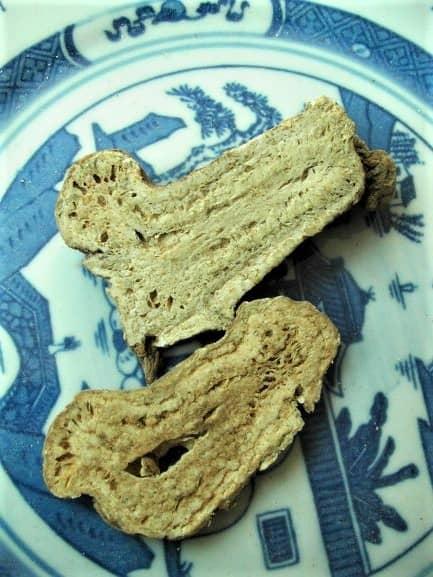Rhizoma Atractylodis Macrocephalae
- Name
- Origin
- Where Does It Grow?
- Nature and Flavor
- Identified Active Components / Major Chemical Constituents
- Drug Actions in TCM
- Traditional Uses in TCM
- Pharmacological Actions
- Toxicology
- Administration and Dosage
- Adverse Effect, Side Effects and Cautions
- References
Name
Latin Name: Rhizoma Atractylodis Macrocephalae
Common Name: Largehead atractylodes rhizome
Scientific Name: Atractylodes macrocephala Koidz.
Chinese Name: 白朮
Pinyin Name: bai zhu
Origin
The herb is the tuber of Atractylodes macrocephala Koidz, a perennial herbal plant of the Compositae family. The medicinal part is used in raw or fried form.1
Where Does It Grow?
Largehead atractylodes rhizome is mainly produced in provinces like Zhejiang, Anhui, Hubei, Hunan, and Jiangxi. Nowadays, it is provided by cultivation.1
Nature and Flavor
Largehead atractylodes rhizome is warm in nature, sweet and bitter in flavor, and mainly manifests its therapeutic actions in the spleen and stomach meridians.2
Identified Active Components / Major Chemical Constituents

Drug Actions in TCM
Largehead atractylodes rhizome can invigorate spleen, replenish qi (vital energy), induce urination, dry the body, control sweating and prevent abortion.2Traditional Uses in TCM
Pharmacological Actions
Toxicology
Largehead atractylodes rhizome decoction injected (i.p.) in mice, the LD50 was found to be 13.3g/kg. When mice were administered by gavage with largehead atractylodes rhizome decoction (0.5g/kg) for 14 consecutive days, white blood cells, in particular the lymph cells, were reduced. After two months, there was mild anemia. Some of them had observed pathological changes in the epithelial cells of kidney tubules.4
Administration and Dosage
Orally, the usual dose is 10~15g, it can be up to 30g if necessary, for preparations such as decoctions, pills, powders or syrups. The raw herb is usually suggested for drying the body, promote urination, consolidating the body surface and arresting sweating; the fried herb is suggested for invigorating the spleen, harmonizing the stomach, and preventing abortion; the deep roasted herb is suggested for promoting digestion and absorption, stimulating appetite, and arresting diarrhea.2
Adverse Effect, Side Effects and Cautions
References
- Li Jiashi (editor-in-chief), Chinese Medicine Identification, Shanghai Scientific and Technical Publishers, 2000-2.
- Lui Daiquan (editor-in-chief), Chinese Herbal Medicine, Shanghai Scientific and Technical Publishers, 2000-6.
- Tao Yufeng, Clinical Herbal Medicine, People’s Medical Publishing House, 2005-5.
- Chen Pian, Clinical Application of Tonifying Herbs, Second Military Medical University Press, 2008.
- Zhao Zhongzhen & Xiao Peigen (editor-in-chief), Contemporary Medicinal Herbal Glossary, Hong Kong Jockey Club Institute of Chinese Medicine, 2006-8.


